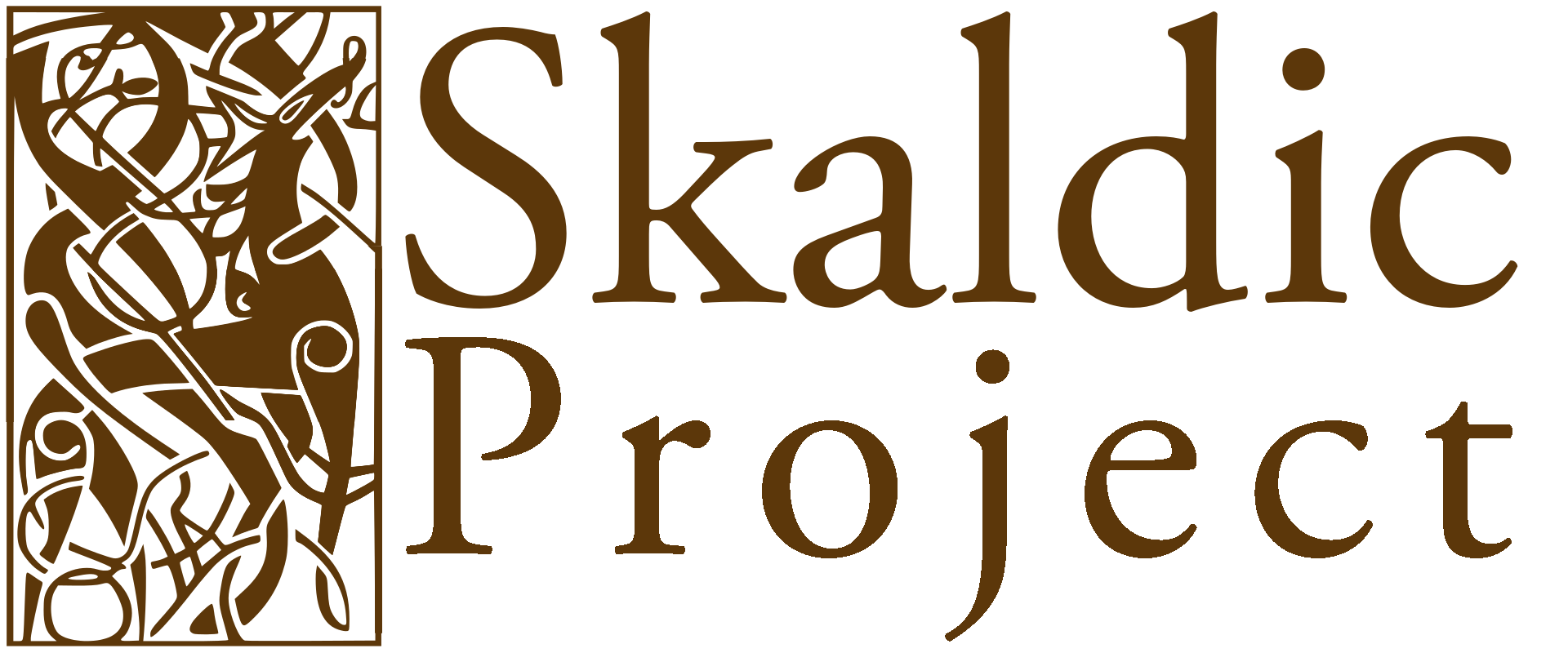Ill Har 4II
Kari Ellen Gade (ed.) 2009, ‘Illugi bryndœlaskáld, Poem about Haraldr harðráði 4’ in Kari Ellen Gade (ed.), Poetry from the Kings’ Sagas 2: From c. 1035 to c. 1300. Skaldic Poetry of the Scandinavian Middle Ages 2. Turnhout: Brepols, p. 285.
Brauzt ‘you subjugated’
(not checked:)
brjóta (verb; °brýtr; braut, brutu; brotinn): to break, destroy
und ‘for’
(not checked:)
3. und (prep.): under, underneath
[1] und: so 39, F, J2ˣ, FskAˣ, H, Hr, um Kˣ, undir FskBˣ
Míkjál ‘Michael’
(not checked:)
Mikjáll (noun m.): [Michael]
notes
[1] Míkjál ‘Michael’: Michael IV Katallaktos was Byzantine emperor from 11 April 1034 until his death on 10 December 1041. He ruled jointly with Empress Zoe.
mæztan ‘most esteemed’
(not checked:)
2. mærr (adj.): famous
[1] mæztan: mætan FskBˣ, mestan FskAˣ, H, Hr
môgum ‘brothers-in-law’
(not checked:)
mágr (noun m.; °-s, dat. -i/-; -ar): brother-, father-, or son-in-law
[2] môgum: mgu 39, F
heim ‘home’
(not checked:)
heim (adv.): home, back
sem ‘as’
(not checked:)
sem (conj.): as, which
frôgum ‘we [I] have heard’
(not checked:)
1. fregna (verb): hear of
sonr ‘son’
(not checked:)
sonr (noun m.; °-ar, dat. syni; synir, acc. sonu, syni): son
[3] sonr: son 39, F, sunr FskBˣ, FskAˣ
kennings
sonr Buðla‘Buðli’s son ’
= Atli
Buðli’s son → Atli
Buðla ‘Buðli’s’
(not checked:)
Buðli (noun m.): Buðli
kennings
sonr Buðla‘Buðli’s son ’
= Atli
Buðli’s son → Atli
bauð ‘invited’
(not checked:)
bjóða (verb; °býðr; bauð, buðu; boðinn (buð- Thom¹ 5²n.)): offer, order, invite
[3] bauð sínum: rauð sinni F
sínum ‘his’
(not checked:)
3. sinn (pron.; °f. sín, n. sitt): (refl. poss. pron.)
[3] bauð sínum: rauð sinni F
sunn ‘the southern’
(not checked:)
sunn- ((prefix)): [Sunn, southern] < Sunnlǫnd (noun n.)
[4] sunn‑: sann‑ J2ˣ, ‘sonn‑’ FskBˣ, sund‑ Hr
notes
[4] sunnlǫnd ‘the southern lands’: Sicily, southern Italy and North Africa. For these campaigns, see also Hharð Gamv 2, Hharð Lv 10, ÞjóðA Sex 2-8, ÞjóðA Lv 4, Bǫlv Hardr 3-5, Valg Har 1-4, ÞSkegg Hardr, Þfisk Lv 2-3, ESk Geisl 51-3VII, Sigfús Blöndal 1978, 59-71 and Jesch 2001a, 88-9.
lǫnd ‘ lands’
(not checked:)
land (noun n.; °-s; *-): land < Sunnlǫnd (noun n.)
notes
[4] sunnlǫnd ‘the southern lands’: Sicily, southern Italy and North Africa. For these campaigns, see also Hharð Gamv 2, Hharð Lv 10, ÞjóðA Sex 2-8, ÞjóðA Lv 4, Bǫlv Hardr 3-5, Valg Har 1-4, ÞSkegg Hardr, Þfisk Lv 2-3, ESk Geisl 51-3VII, Sigfús Blöndal 1978, 59-71 and Jesch 2001a, 88-9.
Haraldr ‘Haraldr’
(not checked:)
Haraldr (noun m.): Haraldr
rǫndu ‘with the shield’
(not checked:)
rǫnd (noun f.; °dat. -/-u; rendr/randir): shield, shield-rim
Interactive view: tap on words in the text for notes and glosses
Haraldr campaigned in Africa as the leader of the Byzantine Emperor Michael Katallaktos’s Varangian army.
[2-3]: The event alluded to in the embedded clauses, namely, how Atli invited his brothers-in-law, the Gjúkungar, to his stronghold to kill them, is described in Akv and Am (NK 240-63). See also SnE 1998, I, 48. Atli was the ON name for Attila, the leader of the Huns (d. 453).
Stanza/chapter/text segment
Use the buttons at the top of the page to navigate between stanzas in a poem.
Information tab
- text: if the stanza has been published, the edited text of the stanza and translation are here; if it hasn't been published an old edition (usually Skj) is given for reference
- sources: a list of the manuscripts or inscriptions containing this stanza, with page and line references and links (eye button) to images where available, and transcription where available
- readings: a list of variant manuscript readings of words in the main text
- editions and texts: a list of editions of the stanza with links to the bibliography; and a list of prose works in which the stanza occurs, allowing you to navigate within the prose context
- notes and context: notes not linked to individual words are given here, along with the account of the prose context for the stanza, where relevant
Interactive tab
The text and translation are given here, with buttons to toggle whether the text is shown in the verse order or prose word order. Clicking on indiviudal words gives dictionary links, variant readings, kennings and notes, where relevant.
Full text tab
This is the text of the edition in a similar format to how the edition appears in the printed volumes.
Chapter/text segment
This view is also used for chapters and other text segments. Not all the headings shown are relevant to such sections.
